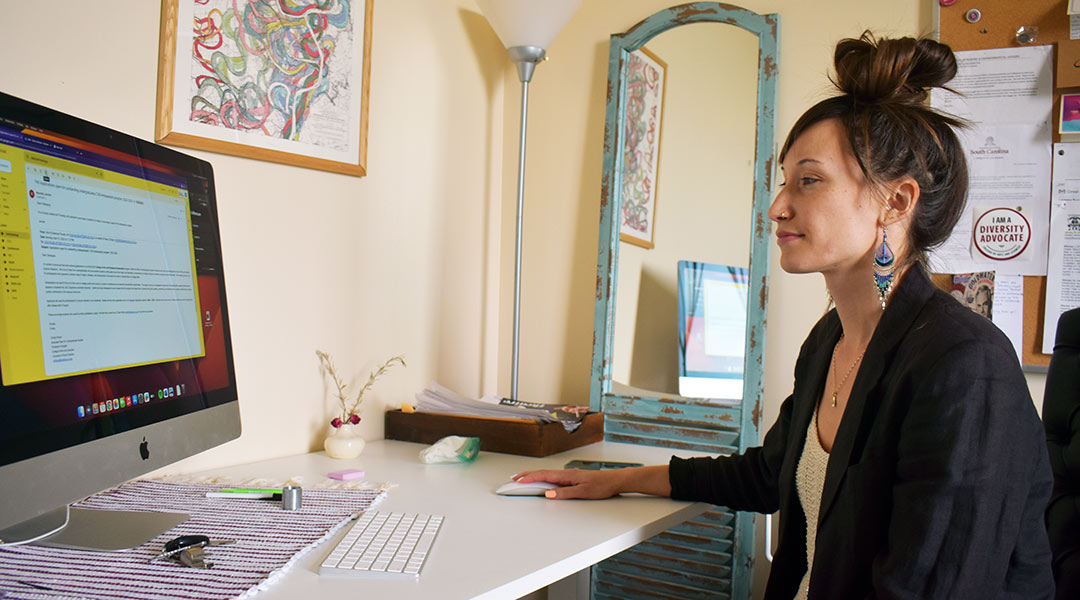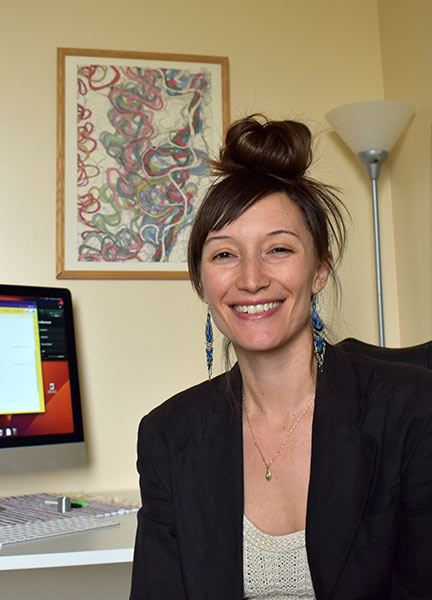Monica Barra was hired at USC in 2018, at the same time as she was defending her thesis for her doctoral degree. (Photos by Danielle Cahn)
Monica Barra, a professor of anthropology at USC, has been heralded as a breakthrough star by the university for her research in environmental justice.
She came to the the University of South Carolina in 2018. But her professional journey began in 2015, when she visited the small town of Ironton, Louisiana.
She wanted to research her big question: “How is science being used to respond to these kinds of bigger existential and ecological questions of wetland loss, but also cultural loss?”
Barra has brought awareness to the vulnerability of, specifically, African American communities as environmental restoration efforts increase across the states.
She has called for researchers and developers to think of ways that can both preserve culture and promote interracial equity while caring for the environment.
“Her work really profoundly and powerfully speaks to the role of scientific decision making within coastal governance,” said Nathan Jessee, an environmental fellow at Princeton University and a former colleague of Barra’s. “Her scholarship made me think differently about science and the role of science.”
For her doctoral research, Barra set out to write “Good Sediment,” a research article that examines the relationship between a rural, African American community in Louisiana and the state’s pending plan to restore the wetlands surrounding them.
Barra found the people who lived near those wetlands had a different vision of restoring their community. They needed the state to address social and political inequalities that ecological work does not address, and in some cases worsens.
She saw a variety of arguments from states that actually could hurt communities and restoration projects.
“A lot of the arguments for the big restoration projects are, …‘This is just how a Delta River builds land,’” Barra said. “‘Let it (the river) flood the wetlands. The wetlands will be built up. It’s not our fault that people live down there now.’”
In Louisiana, those communities thought it did matter.
The wetlands restoration could change how local fisheries in the region have operated for generations.
Community members are worried that vital source of income could disappear entirely.
And while wetlands restoration would protect New Orleans from flooding, it could put the people of Ironton more at risk.
A storm surge could make some of their homes uninhabitable, and the process of leaving can be fraught.
“These are multi-generational communities,” Barra said. “It’s not just a kind of individual model of relocation. … Are you going to move a family cemetery? Are you going to move a community church? And these are real questions that communities have to face, and they already are.”
Triste Cosse’, a resident who lives and works near Ironton, said Barra and her research were genuine and brilliant.
“She was very knowledgeable about my community, and I could tell that she came in for the right reasons,” Cosse’ said. “We have a history of people coming in and just kind of wanted to pick our brains just for not the correct reasons, just to see and gain resources from us. But when Dr. Barra came, she just truly wanted to learn about the people and just understand our environment.”
Barra helped build the town’s first community garden by getting involved in the with Cosse’s’ nonprofit organization, R.E.A.C.H. Out Nola.
Cosse’ said Barra’s personal touch and compassion for the community turned their professional relationship into a lifelong friendship.
“She’s just a ball of light and truly, truly genuine,” Cosse’ said. “And if you speak to her, you don’t feel like you meet a stranger. We had the interview (for Barra’s research) in my grandmother’s home and we just chatted up for hours and just had a conversation. She just became a part of our family.”
Barra is building on her body of research at USC.
She hopes to bring her passion for people and a fresh perspective to issues that affect South Carolina’s cultural heritage and shoreline.
She’s now researching the Gullah community in coastal South Carolina, focusing on how a legal institution known as ‘heir’s property’ makes their generationally owned land vulnerable to developers.
She’s also expanding “Good Sediment” into a book. She hopes it will provide a path forward for scientists to consider more holistic visions of environmental restoration, racial equity and cultural preservation.
And, as environmental innovation progresses faster and faster, it becomes more important to consider the histories of marginalized groups on the front lines of climate change.
“This kind of research is only going to get more important as new kinds of climate innovation, climate adaptation and mitigation innovations are developed and deployed,” Jessee said. “There’s a real need to not forego these histories and ongoing struggles for environmental justice.”



